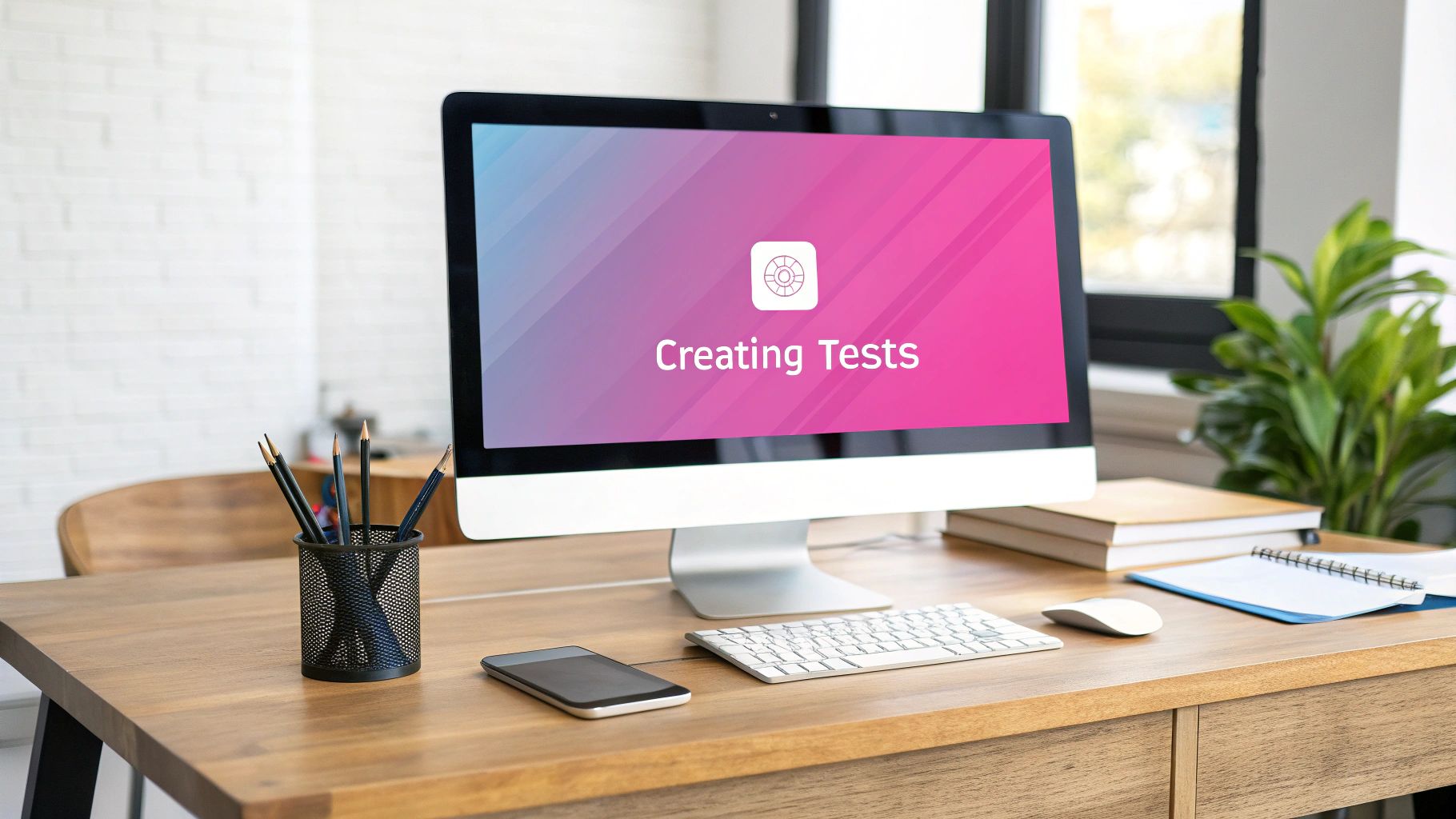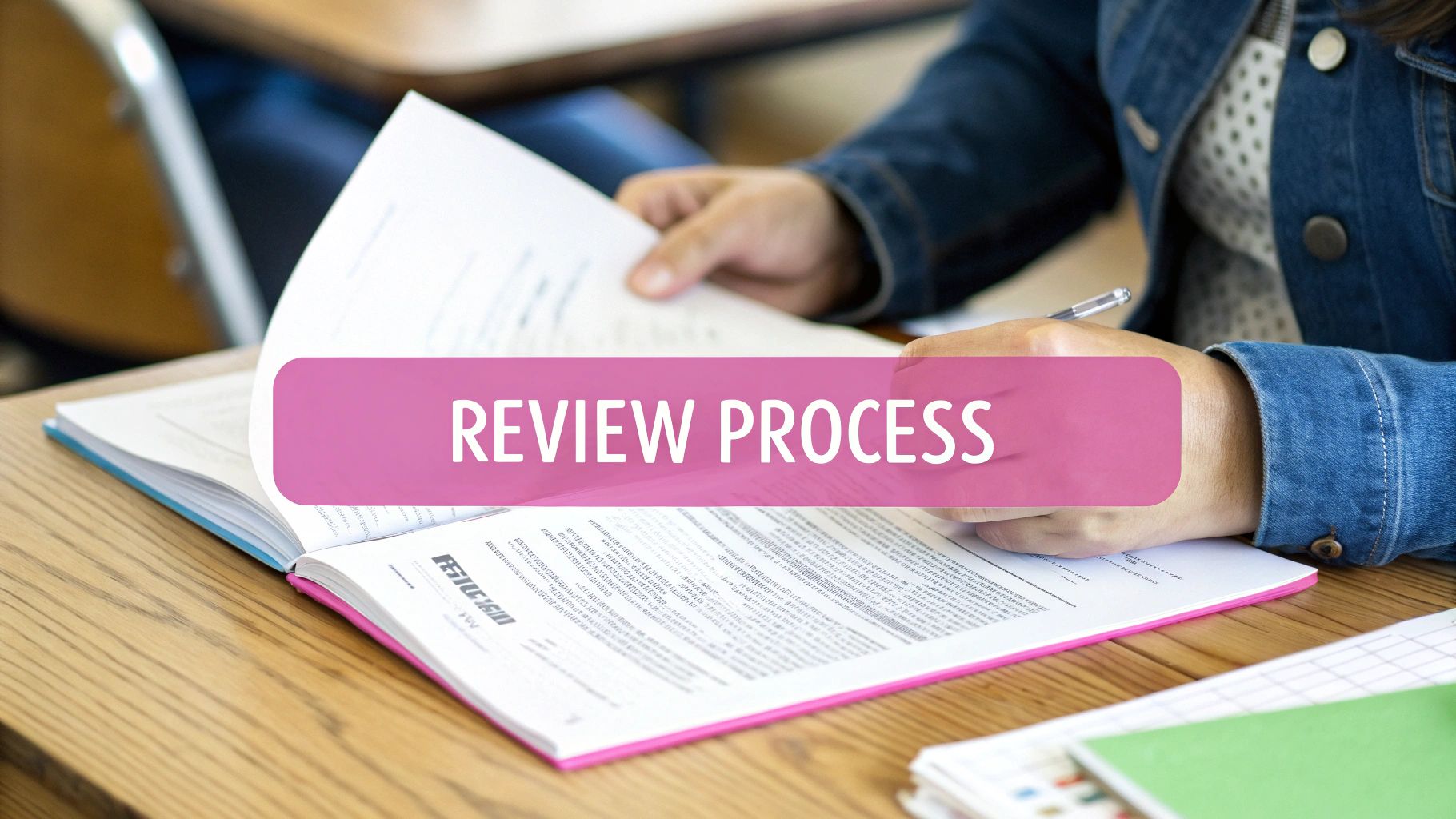
How to Create Practice Tests: A Step-by-Step Guide for Modern Educators
The Science of Effective Practice Testing

Practice testing is more than just assembling random questions – it's backed by research in cognitive psychology and educational best practices. At its core is the "testing effect," where the act of recalling information strengthens memory and improves understanding over time. Even without immediate feedback, the mental process of retrieving information during practice tests helps cement learning. Let's explore how to create practice tests that take full advantage of this cognitive science.
Why Practice Tests Matter
Practice tests do much more than just assess knowledge – they actively help students learn better. They provide a safe environment where students can apply concepts and identify gaps in their understanding. For instance, a student might grasp theoretical physics principles but struggle to solve actual problems. Practice tests also help reduce test anxiety by familiarizing students with exam formats and time constraints. This familiarity is especially important for timed exams where managing time pressure is critical for success.
Building a Better Practice Test: Key Considerations
Creating effective practice tests requires careful planning around several elements. The difficulty should match the real exam while gradually increasing to stretch students' abilities without overwhelming them – similar to training for a race by slowly building up distance. Question types need to mirror the actual test to prepare students for specific mental tasks they'll face. For example, if the final includes essay questions, practice tests should incorporate essay writing to develop those specific skills.
Optimizing Question Design
How questions are written directly impacts their effectiveness as learning tools. Questions need clear, straightforward wording to test subject knowledge rather than confuse students with tricky phrasing. Including different question formats helps assess various skills – multiple choice for fact recall, essays for analysis and critical thinking, and short answer for concise explanation. This mix of formats creates a more complete picture of student understanding while accommodating different learning styles.
The Power of Feedback and Review
Taking practice tests alone isn't enough – thoughtful feedback makes the difference. Detailed explanations for both correct and incorrect answers help students grasp key concepts and identify weak areas. Think of it like having a coach who explains not just what went wrong but how to improve. The review process after each test, especially focusing on missed questions, helps reinforce learning and prepares students for future challenges. When practice tests combine smart design with meaningful feedback, they become powerful tools for building both knowledge and confidence.
Building Your Test Creation Framework

Creating effective practice tests requires careful planning and a structured approach – much like an architect designing a building. Rather than randomly assembling questions, you need to consider how each element works together to help students learn and prepare effectively. Let's explore the key components of building practice tests that truly support student learning.
Defining Learning Objectives and Cognitive Levels
Start by identifying exactly what knowledge and skills you want to assess. For instance, if students need to master statistical hypothesis testing, your practice questions should allow them to demonstrate and apply this specific knowledge. Mix up the types of thinking required – include some basic recall questions along with problems that ask students to analyze, evaluate and apply concepts in new ways. This creates a well-rounded assessment that checks understanding at different levels.
Structuring Your Practice Test: A Blueprint for Success
After setting clear objectives, map out your test structure. Decide what types of questions to include and how to distribute them across topics. For example, a statistics practice test might be 20% multiple-choice questions on key terms, 40% calculation problems, and 40% applied questions using real data. This balanced approach ensures you're testing various skills while matching the actual exam format. Planning the structure up front helps create focused, purposeful practice materials.
Setting Time Limits and Scoring Systems: Realistic Expectations
Make practice conditions match the real exam environment. Time limits should be proportional – if the final is two hours, a one-hour practice test should cover about half the material. Be transparent about scoring by providing clear rubrics that explain point values. When students understand exactly how they'll be evaluated, they can better focus their preparation on key areas needing improvement.
Balancing Difficulty and Consistency: The Goldilocks Principle
Practice tests should start slightly easier than the final exam and gradually increase in difficulty. Just as athletes progressively challenge themselves in training, students benefit from practice that builds in complexity over time. Keep formats, content coverage, and overall difficulty consistent between practice tests and the final exam. This helps students accurately gauge their progress and prevents unwelcome surprises on test day. The goal is to build student confidence through structured practice while developing deeper mastery of the material.
Crafting Questions That Actually Work
Making effective practice tests is a skill that goes far beyond just writing random questions. By studying how successful AP and college courses design their assessments, we can learn to create questions that truly help students learn and demonstrate their knowledge.
Writing Clear and Unambiguous Questions
Good questions start with clarity. When questions are unclear or confusing, students struggle to show what they really know. Each question should focus on testing one specific concept or skill, using straightforward language that students can easily understand. For instance, rather than asking "What are the ramifications of fiscal policy?", ask "How does expansionary fiscal policy affect inflation and unemployment?" This direct approach lets students concentrate on demonstrating their understanding rather than decoding complex wording. When questions are clear, students can tackle them with confidence.
Designing Scenario-Based Problems
Real-world scenarios make questions more engaging and meaningful. This approach works especially well for subjects like statistics where students need to apply formulas to practical situations. Instead of asking students to calculate a simple probability, present a concrete scenario: "A bag contains 5 red marbles and 3 blue marbles. What is the probability of drawing two red marbles in a row without replacement?" These types of questions help students see how concepts apply to actual situations while building their problem-solving abilities.
Avoiding Common Pitfalls in Question Writing
Several mistakes can make practice questions less effective. Questions that are too easy or too hard don't give an accurate picture of student understanding. Including extra details that aren't relevant to solving the problem can distract students from the main concept being tested. For example, when creating practice tests about how to write good test questions, keep the focus on key skills like question design and cognitive level targeting. Also, phrase questions positively rather than negatively – negative wording adds unnecessary complexity and can confuse students. Being mindful of these common issues helps ensure questions serve their intended purpose.
Creating Effective Options for Multiple-Choice Questions
In multiple-choice questions, the answer choices are just as important as the question itself. Each option should be reasonable and related to the topic, not obviously wrong answers that waste space. Well-designed options can reveal specific gaps in understanding – if students consistently pick certain wrong answers, it shows which concepts need more review. The correct answer must be clearly right and supported by facts from the course material. This careful attention to answer choices turns multiple-choice questions into valuable tools for identifying both strengths and areas for improvement.
Leveraging Technology Without Losing Control

Technology provides powerful tools to create and deliver practice tests more effectively. However, it's essential to use these resources thoughtfully to maintain educational quality and assessment integrity. By carefully selecting platforms, protecting academic standards, and using automation strategically, educators can enhance their testing practices while staying true to sound assessment principles.
Choosing the Right Platform: A Balancing Act
Finding the ideal technology solution requires carefully evaluating your specific teaching context and needs. Key considerations include whether you need integration with your current learning management system and if automated grading would be beneficial. Some platforms work best for multiple-choice questions, while others excel at essay assessments. Accessibility features are also crucial to ensure all students can participate fully. The goal is to select tools that make creating and delivering practice tests easier without compromising quality.
Maintaining Academic Integrity in a Digital Age
Online access to information creates new challenges for preserving academic honesty. Smart technology choices can help address these concerns. For example, using question banks and randomization features ensures students receive different versions of practice tests. Some platforms also offer secure testing environments for high-stakes assessments. These measures help students focus on learning rather than finding shortcuts, creating an environment that rewards genuine effort and understanding.
Automating Feedback: Working Smarter, Not Harder
One major benefit of technology is the ability to provide instant feedback on practice tests. Automated grading saves valuable time that teachers can redirect to instruction and student support. Quick feedback helps students identify areas for improvement and reinforce correct understanding. For instance, tools like Notescast can create short review videos from study materials, giving students additional ways to learn. This rapid feedback cycle helps students progress more quickly.
Practical Applications and Real-World Strategies
Consider these concrete ways to use technology effectively: track student performance across multiple tests using spreadsheets, use online quizzes for quick comprehension checks, and explore specialized software for complex subjects like AP Statistics. By thoughtfully implementing these tools, teachers can both streamline test creation and gather valuable data about student learning. This balanced approach leads to more effective instruction and better outcomes for students.
Turning Test Results Into Teaching Gold

Practice tests are most valuable when you know how to interpret and apply the results effectively. By carefully analyzing test data, you can gain key insights to improve your teaching methods and help students learn better. Think of test results as a roadmap that shows you exactly where to focus your efforts.
Deciphering the Data: More Than Just a Grade
Looking beyond simple percentages reveals much deeper insights about student learning. When multiple students miss the same question, it may point to unclear instruction or a common misunderstanding that needs addressing. Pay attention to which wrong answers students choose most often – this can highlight specific gaps in understanding. By examining patterns in the data, you'll get a much clearer picture of what concepts students have mastered and where they still need support.
From Insights to Action: Adjusting Your Teaching
Once you identify areas where students struggle, you can adapt your teaching accordingly. This might mean spending extra time reviewing difficult topics, creating new practice problems, or trying different teaching methods. For example, if students have trouble applying concepts to real situations, incorporate more practical examples and scenarios into your lessons. Small adjustments based on test data can lead to major improvements in student understanding.
Providing Meaningful Feedback: Guiding Student Improvement
Students need specific, constructive feedback to grow. Instead of vague comments, explain exactly what they did well and where they went wrong. Show them step-by-step how to solve problems correctly and help them understand the reasoning behind each step. This detailed guidance helps students learn from their mistakes and develop better problem-solving skills for the future.
Building Targeted Intervention Plans: Supporting Individual Needs
Since students learn differently and at different paces, use test results to create personalized support plans. Some students may need one-on-one help, while others benefit from extra practice in specific areas. By tailoring your approach to each student's needs, you can help ensure everyone has the opportunity to succeed. This individualized support creates a more effective learning environment for all students.
Tracking Progress Over Time: Measuring Growth and Effectiveness
Regular analysis of test results lets you monitor both individual student growth and the success of your teaching methods. By comparing performance across multiple tests, you can see which approaches work best and where you might need to make changes. This ongoing cycle of assessment, adjustment, and feedback turns practice testing into a powerful tool for continuous improvement in teaching and learning.
Subject-Specific Testing Strategies That Work
Creating effective practice tests requires adapting approaches to match each subject's unique needs and learning objectives. Different subjects demand different testing methods to properly assess student understanding and skills. Here's how to craft practice tests that effectively target the key competencies across major academic disciplines.
Mathematics: Building Conceptual Understanding and Procedural Fluency
Math practice tests need to strike a balance between testing calculation skills and deeper conceptual understanding. Rather than just asking students to solve equations, incorporate real-world applications that require mathematical thinking. For example, instead of directly calculating a circle's area, present a practical scenario where students must determine how much fencing is needed for a circular garden. Include a mix of multiple-choice questions for basic computations and open-response problems that push students to explain their reasoning and problem-solving approach.
Sciences: Integrating Inquiry-Based Learning and Experimental Design
Science tests should mirror the scientific method and focus on analytical thinking over simple fact recall. Include questions that ask students to analyze experimental data, interpret visual information like graphs and charts, and draw evidence-based conclusions. Present scenarios where students must identify variables, form hypotheses, and outline experimental procedures. This helps develop crucial scientific reasoning skills that align with how real scientific research is conducted.
Humanities: Promoting Critical Analysis and Interpretive Skills
For subjects like history and literature, craft questions that develop analytical and interpretative abilities. Rather than testing dates and plot points, ask students to evaluate arguments, analyze primary sources, and construct well-supported interpretations. For instance, a literature test might ask students to compare two characters' motivations and explain how they reflect broader themes in the work. This approach cultivates deeper engagement with humanities content.
Language Arts: Enhancing Reading Comprehension and Effective Communication
Language arts assessments should evaluate both reading comprehension and writing abilities. Include passages followed by questions about main ideas, supporting details, vocabulary in context, and author's purpose. Add writing components where students must organize their thoughts, use proper grammar and mechanics, and communicate ideas persuasively. This comprehensive approach helps develop the full range of language skills students need.
Creating effective subject-specific practice tests requires understanding the core competencies students need to master in each discipline. By carefully designing assessments that target these key skills, teachers can better prepare students for academic success. For help turning your practice materials into engaging video content, check out Notescast. This tool makes it easy to transform study resources into interactive learning experiences that reinforce student understanding.
